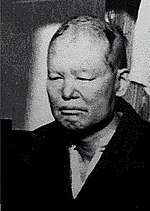Kaijin Akashi
Kaijin Akashi (Japanese: 明石 海人) was the pen name of Shōtarō Noda (野田勝太郎, 5 July 1901 – 9 June 1939), a Japanese poet whose writing was inspired by his diagnosis of leprosy and confinement to a leper colony.[1]

Early life
Akashi was born in Numazu, Shizuoka prefecture on 5 July 1901. He was the third son of a farmer. At the age of twenty, he graduated from Shizuoka Normal School with a license to teach elementary school. He worked as a teacher until 1926.[2][3] In 1924, he married Asako Furugōri, also an elementary school teacher.[3] They had two daughters, born in February 1925 and late 1926.[2][3]
Leprosy and poetry
Akashi began to show symptoms of leprosy in early 1926, and was diagnosed that same spring.[2][3] He retired from teaching after his diagnosis and was soon subjected to the mandatory quarantine regime in practice in Japan at that time.[3] In the following year, he was hospitalized in Akashi Rakusei hospital (明石楽生病院),[3] which stood in what is now Nishi-ku, Kobe.[4] When this facility closed in 1932, he was moved to the leper colony Nagashima Aiseien Sanatorium.[3]
While at Nagashima Aiseien, Akashi learned to write traditional Japanese poetry, primarily tanka. His poems were published in the sanatorium's magazine, Aisei;[3] and he became one of the best-known of a group of leprosy patients who wrote poetry and prose about their condition, a genre referred to as "leprosy literature" until the 1940s.[5][6]
Akashi's health deteriorated as a result of his condition, and in autumn of 1936, he went blind.[2] On 11 November 1938, he underwent a tracheotomy as a result of difficulty in breathing.[2] On 9 June 1939, he died at the sanatorium of intestinal tuberculosis.[2]
He published his most successful work, Hakubyō, in 1939, shortly before his death.[7][8] It sold over 250,000 copies[note 1] and drew significant attention to the plight of leprosy patients in Japan.[8][9] Hakubyō was a bittersweet work, exploring Akashi's grief over his condition and the loneliness that stemmed from his lengthy mandated isolation, as well as his eventual view that his condition was a gift enabling him to experience beauty and insight beyond the physical world.[8]
Legacy
Akashi's work continues to be read and studied by contemporary scholars.[3] Inspired by Akashi's poetry, Japanese photographer Atsushi Fujiwara photographed the decaying remains of Nagashima Aiseien for his 2015 book Poet Island.[10] Four monuments honoring Akashi were erected in his home town of Numazu in 2001.[3]
Books of verse by Akashi
- 海人遺稿 (Kaijin ikō). Tokyo: Kaizōsha, 1939. NCID BA32958162, OCLC 672684061.
- New edition. Tokyo: Ozorasha, 1998. ISBN 475680439X.
- 白描 明石海人歌集 (Hakubyō: Akashi Kaijin kashū). Tokyo: Kaizōsha, 1939. NCID BN12555325, OCLC 674958110. (transl. A Plain Sketch; 1939)[8][11][12]
- 明石海人全集 (Akaishi Kaijin zenshū). 2 vols. Tokyo: Kaizōsha, 1941. NCID BN11353584, OCLC 672411359.
- New edition. Takeshi Muramatsu, et al, eds. 海人全集 (Kaijin zenshū). 3 vols. Tokyo: Koseisha, 1993. NCID BN0950746X, OCLC 51018011.
- Hiroto Uchida, ed. 明石海人全歌集 (Akaishi Kaijin zenkashū). Tokyo: Tanka-shinbun-sha, 1978. NCID BN0738216X, OCLC 673783389.
- Osamu Murai, ed. 明石海人歌集 (Akashi Kaijin kashū). Tokyo: Iwanami, 2012. ISBN 9784003119013.
Notes
- The figure of 250,000 copies is generally cited, but the collection 『海人全集』 (Kaijin zenshū) says 25,000. This much lower figure does not seem to be a typographical error.
References
- "明石海人". デジタル版 日本人名大辞典+Plus on kotobank.jp (in Japanese). 20 January 2009. Retrieved 28 February 2012.
- Hisayo, Okano. "明石海人の年譜". web.thn.jp. Retrieved 10 August 2019.
- Mitsuho Ikeda, 明石海人(1901-1939), Ikeda's website (University of Osaka).
- 平田勝政, 1920年代のハンセン病問題と社会事業(第5報) 治療解放主義の系譜(楽生病院)の検討, Japanese Society for the Study of Social Welfare, 2010.
- Tanaka, K. M. (15 November 2013). "Contested Histories and Happiness: Leprosy literature in Japan". Health, Culture and Society. 5 (1): 104. doi:10.5195/hcs.2013.133. ISSN 2161-6590.
- Tanaka, Kathryn (3 May 2016). "Writing Ties in Japan: Family, Familialism, and Children's Writing in an Early Twentieth-century Hansen's Disease Hospital". Japanese Studies. 36 (2): 231–250. doi:10.1080/10371397.2016.1208529. ISSN 1037-1397.
- "Kaijin Akashi | International Leprosy Association - History of Leprosy". leprosyhistory.org. Retrieved 7 August 2019.
- Miyasaka, Michio (2014). "Justice of Listening: Japanese Leprosy Segregation" (PDF). In Jensen, Meg; Jolly, Margaretta (eds.). We Shall Bear Witness: Life Narratives and Human Rights. University of Wisconsin Press. p. 9.
- Australia, Oriental Society of (1992). The Journal of the Oriental Society of Australia. Oriental Society of Australia.
- Kōtarō Iizawa, Fujiwara Atsushi, Shijin no shima (藤原敦「詩人の島」), Artscape, 15 April 2015.
- "Atsushi Fujiwara: 'Poet Island': Soul-Stirring Photos of Sanatoriums in Japan's Nagashima Island | Photography | Emaho Magazine". www.emahomagazine.com. Retrieved 7 August 2019.
- Australia, Oriental Society of (1992). The Journal of the Oriental Society of Australia. Oriental Society of Australia.
Further reading
- The Oral History Project - That Spark of Soul Incarnate - Kaijin Akashi, Honami Nagata and Haruko Tsuda
- ILEP: Unique Collection of Writings by Japanese Persons Affected by Leprosy
- Web page (in Japanese) about Akashi
- Mitsuho Ikeda and Hideaki Matsuoka (松岡秀明), "Lepers, Nation-State, and Empress Dowager: A Prolegomena to medical anthropology of bio-power governmentality", Ikeda's website (University of Osaka).
- Yoshiko Ikeda, "An Epidemic of Emotional Disturbance among Leprosarium Nurses in a Setting of Low Morale and Social Change." Psychiatry: Interpersonal and Biological Processes 29 (1966). doi:10.1080/00332747.1966.11023460.